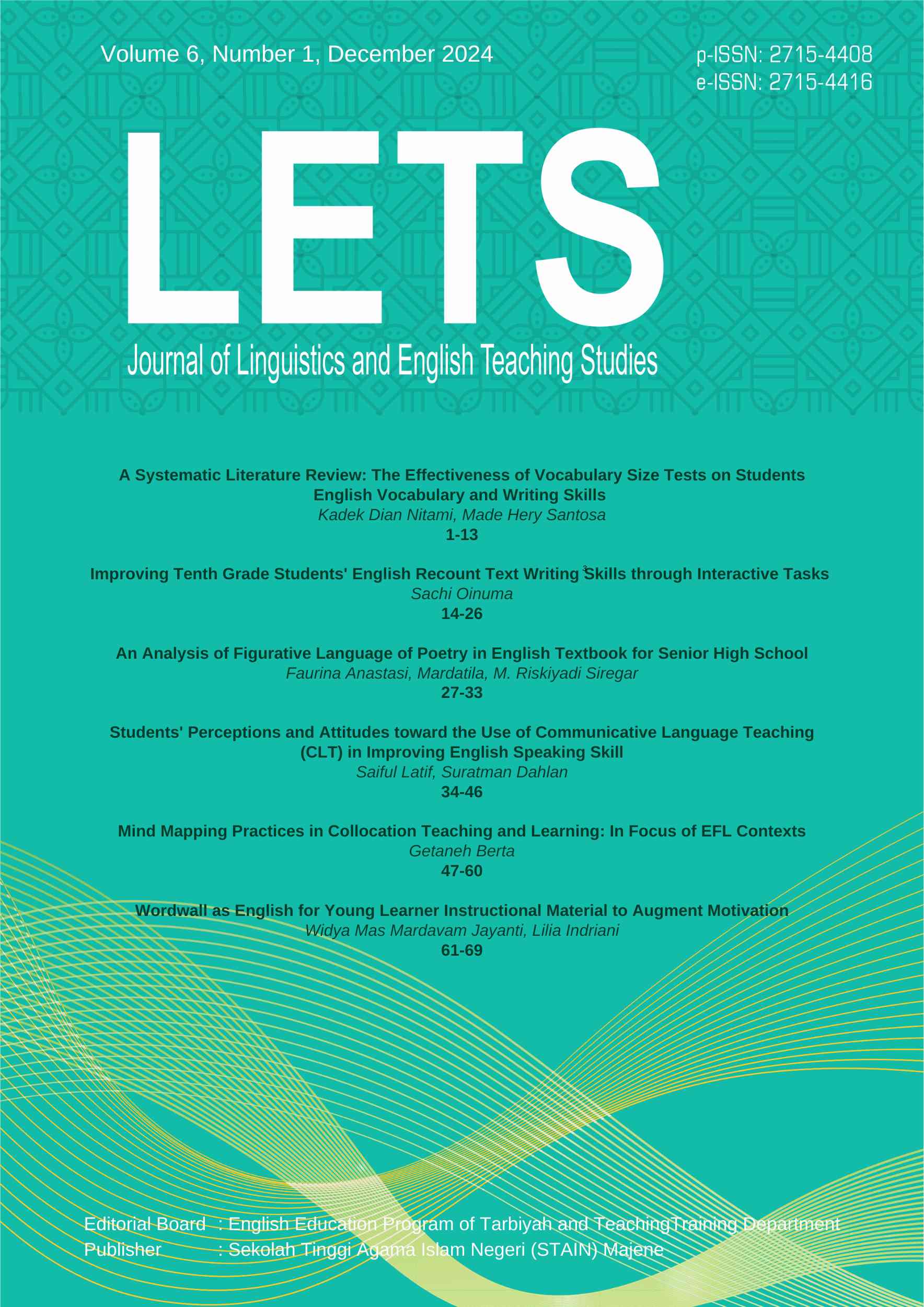Improving Tenth Grade Students' English Recount Text Writing Skills through Interactive Tasks
DOI:
https://doi.org/10.46870/lets.v6i1.1151Keywords:
English Writing Skills, Recount Text, Classroom Action Research, Innovative Teaching StrategiesAbstract
This study investigates the effectiveness of innovative methods to enhance tenth grade students’ English writing proficiency at SMK IPTEK Weru Sukoharjo, focusing on recount text. Using Classroom Action Research (CAR), the study employed both qualitative and quantitative approaches, including observations, interviews, and pre-test and post-test. The findings indicate that interactive and collaborative writing exercises, supported by multimedia resources and constructive feedback, significantly improved students’ writing skills and engagement. However, the challenges using vocabulary and organizing recount narratives highlights areas for further pedagogical improvement. The study underscores the importance of dynamic, student-centered English writing instruction tailored to vocational education to better prepare students for future academic and professional pursuits.
References
Amri, Z. (n.d.). Classroom Action Research and Lesson Study: How Do They Work for Lecturers and High School English Teachers. http://www.m-edukasi.web.id/
Amrizal, A., Hartono, R., Rukmini, D., Mujiyanto, J., & Kassymova, G. (2024). Students’ Perception of Electronic Feedback: Lecturer, Peer, and Self-Electronic Feedback on Writing Academic with Different Students’ Writing Achievement. Journal of Curriculum and Teaching, 13(5), 145. https://doi.org/10.5430/jct.v13n5p145
Awacorach, J., Jensen, I., Lassen, I., Olanya, D. R., Zakaria, H. L., & Tabo, G. O. (2021). Exploring Transition in Higher Education: Engagement and Challenges in Moving from Teacher-Centered to Student-Centered Learning. Journal of Problem Based Learning in Higher Education, 9(2), 113–130. https://doi.org/10.5278/ojs.jpblhe.v9i2.5262
Damanik, J. Y. (2022). Peer Feedback to Improve Indonesian Adult Learners’ Writing Skills: A Review. JET (Journal of English Teaching), 8(1), 49–58. https://doi.org/10.33541/jet.v8i1.3253
Demneri, E. (2024). Students’ Difficulties in Writing in English Language. Proceedings of The International Conference on Modern Research in Education, Teaching and Learning, 3(1), 35–41. https://doi.org/10.33422/icmetl.v3i1.290
Generoso, J. C., & Arbon, A. M. M. (2020). Language needs analysis: An EAP curriculum design to develop foreign students’ English skills. Journal of Asia TEFL, 17(2), 428–445. https://doi.org/10.18823/asiatefl.2020.17.2.8.428
Hu, Y. (2023). Examining the effects of teacher self-compassion, emotion regulation, and emotional labor strategies as predictors of teacher resilience in EFL context. Frontiers in Psychology, 14. https://doi.org/10.3389/fpsyg.2023.1190837
Jelisavac, D. (2024). The Impact Of Teachers’ Attachment Styles On Their Relationship With Students In Additional Professional Support Roles. https://www.researchgate.net/publication/385343078
Jubhari, Y., Sasabone, L., & Nurliah, N. (2022). The Effectiveness of Contextual Teaching and Learning Approach in Enhancing Indonesian EFL Secondary Learners’ Narrative Writing Skill Article History Keywords CTL EFL Narrative text Contextual teaching Quasi-experimental. Journal of Research and Innovation in Language ISSN, 4(1), 54–66. https://doi.org/10.31849/reila.8633
Kessler, M. (2020). Technology-Mediated Writing: Exploring Incoming Graduate Students’ L2 Writing Strategies with Activity Theory. Computers and Composition, 55. https://doi.org/10.1016/j.compcom.2020.102542
Kynat Javaid, Z., Ajid, A., Ramzan, M., & Ajid Ali, A. (2023). Perception of Students about Collaborative Strategies Employed by Teachers for Enhancing English Vocabulary and Learning Motivation. Pakistan Journal of Law, 2. http://www.pjlaw.com.pk
Lian, A., Thi, V., Ho, M. L., & Minh, C. (2024). Theory and Practice in Language Studies. 14(9). https://www.researchgate.net/publication/384679776
Morris, R., Perry, T., & Wardle, L. (2021). Formative assessment and feedback for learning in higher education: A systematic review. In Review of Education (Vol. 9, Issue 3). John Wiley and Sons Inc. https://doi.org/10.1002/rev3.3292
Pramilaga, N. M., Putra, I. N. A. J., & Suprianti, G. A. P. (2023). Improving Students’ Writing Skill by Using Pictures in Vocational High Schools. Journal of Education Action Research, 7(4), 588–602. https://doi.org/10.23887/jear.v7i4.68954
Putu Restu Adi Utami, L., Komang Arie Suwastini, N., Rasben Dantes, G., Turut Suprihatin, C., & Eva Krishna Adnyani, K. (2021). Virtual Reality for Supporting Authentic Learning in 21st-Century Language CLASSROOM. Jurnal Pendidikan Teknologi Dan Kejuruan, 18(1).
Radish Charica Dewi, B., & Wahyuni, S. (n.d.). Enhancing Students’ English Learning Motivation Through Differentiated Instruction with Fun Game Activities.
Rosenfeld, M. (2024). Continuing language teacher education: L2 experienced teachers engage in the craft of creative writing. Journal of Language Teaching, 4(2), 12–26. https://doi.org/10.54475/jlt.2024.007
Wekerle, C., Daumiller, M., & Kollar, I. (2022). Using digital technology to promote higher education learning: The importance of different learning activities and their relations to learning outcomes. Journal of Research on Technology in Education, 54(1), 1–17. https://doi.org/10.1080/15391523.2020.1799455
Xu, E., Wang, W., & Wang, Q. (2023). The effectiveness of collaborative problem solving in promoting students’ critical thinking: A meta-analysis based on empirical literature. In Humanities and Social Sciences Communications (Vol. 10, Issue 1). Springer Nature. https://doi.org/10.1057/s41599-023-01508-1
Downloads
Published
Issue
Section
License
Copyright (c) 2024 Sachi Oinuma

This work is licensed under a Creative Commons Attribution-ShareAlike 4.0 International License.












